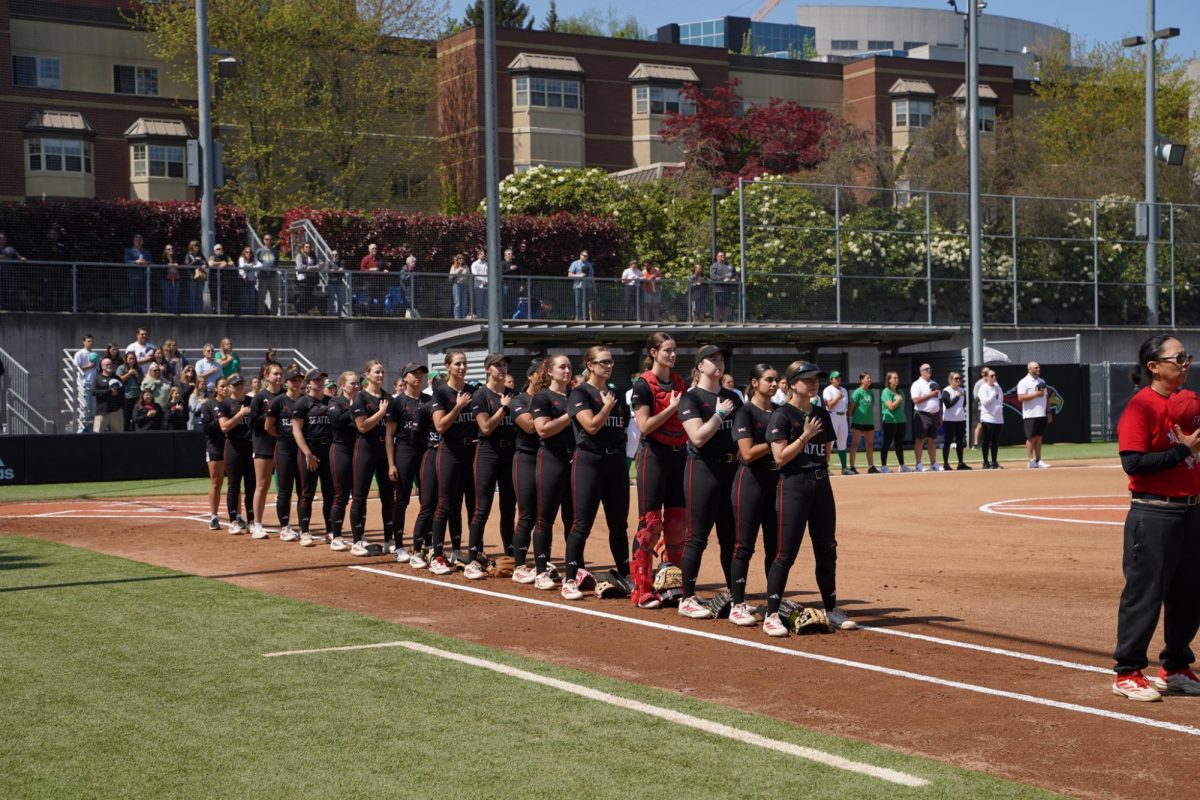“Straight off the bus to the jet,” declared Seyi Reiley as he walked across the tarmac at Boeing Field in a Jan. 17 Instagram video. The Redhawk forward showed off the luxurious travel conditions that the men’s basketball team enjoyed that day; after a charter bus ride directly onto the runway, a jet was waiting to take the team to their next game.
These conditions were an upgrade from traditional traveling conditions for Seattle University Men’s Basketball—the team only used a charter flight to travel to one game during the 2023-2024 season. Usually, they fly to games on commercial flights, which are cheaper and have less of an environmental impact than charter flights.
Still, the video turned some heads on campus. Some students wondered: why did the team fly on a charter jet to their Jan. 18 game against Stephen F. Austin State University in Nacogdoches, Texas, and what does this mean for the Seattle U community?
“The Price of Competition”
The world of U.S. college basketball is a fast-paced one as teams play multiple games a week. Seattle U played three games over a seven-day period multiple times during the 2023-2024 season, usually playing on Thursdays and Saturdays. With a strenuous travel schedule, charter flights are an easy way for teams to avoid wasting time on the road.
Larger universities leverage these resources more often than Seattle U does. In 2019, the Associated Press found that at least 20 public universities in the United States own or share ownership of planes. Seattle U does not own any aircraft.
For larger schools, jet usage is an essential part of athletics travel in a much more significant fashion than at Seattle U. The University of Kansas, which owns a jet, referred to it as, “an efficiency tool with a clear return on investment,” in a 2018 statement to WIBW 13 News.
Seattle U, a mid-major school with far less media traction than that of a “blue blood” school like Kansas, made use of a charter instead. The Jan. 17 Instagram video shows the company that operates the jet, a Milwaukee-based charter jet company called Air Charter Express. The company provided a quote for the cost of a comparable flight with the same origin and destination.
A flight from Boeing Field to A.L. Mangham Jr. Regional Airport in Texas costs $48,825.
Seattle U Athletics declined to share the amount they spent on the charter flight in January.
“$48,000 is a lot of money,” Joy Golondrina, a third-year environmental studies and Spanish double major said. “It could be put into other programs that we have here on campus or it could be going to making the campus more sustainable.”
In a recent interview with The Spectator, Seattle U Director of Athletics Shaney Fink stated that private jet flights provide student-athletes with a competitive advantage. Fink also noted that the men’s basketball team generates significant exposure and revenue for the school, which positions them to leverage these resources.
“It is not unusual for Division I teams who want to compete,” Fink told The Spectator. “This is the price of competition.”
Golondrina took issue with the school’s priorities and Fink’s reasoning behind this instance of private jet usage.
“I think that that accounts for the economic part, but it doesn’t really take into account the environmental aspect and the environmental consequences of doing something like this,” Golondrina said.
Two Sides to Sustainability
Sustainability is important to Seattle U and its students. The campus grounds are pesticide-free, the university recently divested its endowment from fossil fuels, and the Center for Environmental Justice and Sustainability (CEJS) is consistently working on new sustainability projects. Many students take pride in the university’s efforts to reduce negative impacts on the environment.
“The divestment is part of the reason why I literally went to the school,” Alice Gilson, a third-year environmental studies major said.
Gilson currently works for CEJS as a communications program assistant and takes pride in the university’s sustainable mission. She is also involved in Sustainable Student Action (SSA), a club on campus that Gilson says pushes the university to do better.
“We (SSA) take a little bit more [of a] critical take on Seattle U’s sustainability efforts,” Gilson added. “The divestment, we love to flaunt that. But they don’t mention that it was a student effort.”
SSA was founded in 2012. The club was a crucial part of the push for divestment, even when senior faculty at the university were not on board with the initiative.
Riley Lawes, a third-year environmental studies major, sees charter flights as counterproductive to sustainability efforts at the university.
“It makes me question what the university’s end goal is for this because they talk so much about emissions and trying to reduce the amount of emissions,” Lawes said. “And then they go and get a private jet for the basketball team.”
The jet used by Seattle U is a SAAB 2000, operated by Air Charter Express. On a four-hour flight as the men’s basketball team took, a SAAB 2000 burns 1310 gallons of fuel.
Burning this quantity of fuel results in 12,496 kilograms of CO2 emissions, according to the United Kingdom’s Department for Business, Energy, and Industrial Strategy. When 25 people fly commercially from Seattle’s SeaTac airport to Austin, Texas, it emits 6,300 kg of CO2. That represents roughly half of the emissions produced by the private flight.
Athletics air travel accounted for 18.7% of Seattle U’s emissions in 2023, according to the university’s greenhouse gas emissions inventory. Carbon emissions from study abroad air travel made up 10.2% percent of emissions in the 2023 fiscal year.
Yolanda Cieters, associate director of sustainability at CEJS, said that air travel data from athletics, used for greenhouse gas emissions tracking, only includes the origin and destination.
One variable that was not included was the type of plane flown. This distinction is important because private jets emit almost double the CO2 per person compared to a regular commercial flight. The school’s greenhouse gas emissions inventory does not reflect the corresponding emissions increase.
Conference Conundrum
Seattle U is a member of the Western Athletic Conference (WAC). Including Seattle U, there are 11 teams in the conference, spread across the western United States.
The closest school in the WAC to Seattle is Utah Valley University. Utah Valley University is 866 miles from the Seattle U campus, which is a 13-hour drive. The furthest school from Seattle is the University of Texas Rio Grande Valley, which is 2369 miles away. It would take 36 hours to drive from Seattle U to Edinburg, Texas, where the university is located.
“Why are these teams so far south? Why aren’t we playing any teams more north, closer to us, where we could bus?” Lawes said. “I’m surprised there’s no team from Oregon.”
NCAA conferences are complex organizations. The recent demise of the PAC-12 has put a spotlight on the messy business of changing conferences, with negotiations that confound even fully tuned-in sports fans.
Eric Guerra, Seattle U’s senior associate athletic director, addressed that changing conferences is difficult, even though the WAC makes travel more complex for the department.
“I wish it was that simple,” Guerra said. “You know, it’s tough to travel that distance. We’d love to be a little bit closer.”
Guerra indicated that conference conditions seem unlikely to change for Seattle U.
“I don’t know if anything’s going to change in the near future, to be honest with you,” Guerra said. “The WAC is going to stay put for the next few years.”
Guerra further outlined considerations behind the department’s use of charter flights. Commercial flight schedules are not optimized for student-athletes, who play in the afternoon or evening.
“So where we can create a more manageable schedule for their physical well-being and also if we can keep them in class for one additional class block during the day, then that’s a win, right?” Guerra said. “Sometimes with the logistics of trying to do it through commercial… it pencils out to go with a charter flight here or there.”
Still, the cost is higher for charter flights. Guerra declined to share the cost but acknowledged that it was higher than a commercial airline would charge.
Ultimately, the Jan. 17 flight does not signal a shift for athletics. Even though other Division I schools make use of these resources consistently, charter flights will not be consistently used at Seattle U.
“It’s not going to ever be the way we travel, but it’s an option that helps us provide a better experience for our students and puts us in a better position to be competitive,” Guerra said.
Where To Go From Here
Seattle U’s use of private jets could be viewed as largely nominal. One charter flight in a season, even with a large price tag, is a small drop in the bucket of university emissions and expenses. The school limits its use of charter flights when compared to universities whose student populations and carbon footprints are much larger.
However, the dissonance between Seattle U’s student population and the athletics department is unlikely to go away. This also speaks to a gap in institutional priorities at Seattle U; what makes the best economic sense may not always be the preeminent social or environmental choice. But the reality of student-athlete schedules and the large geographic range of the WAC means that the use of charter flights is unlikely to cease entirely.








